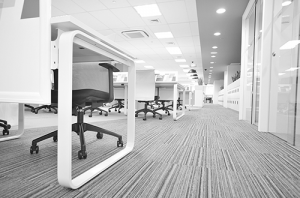Featured Post
Office Furniture for Ergonomic Workstations
Ergonomics in the workplace isn't just a trendy buzzword; it's a crucial aspect of maintaining long-term health and productivity. As employees spend hours at their desks, ensuring their workstation is optimized for comfort and efficiency is essential. Among the various elements that make up an ergonomic workstation, office furniture plays a pivotal role. This article explores the types of office furniture ideal for ergonomic workstations, providing insights into how to create a productive and health-conscious environment.
Understanding Ergonomics
Before diving into specific pieces of furniture, it’s important to understand what ergonomics is. At its core, ergonomics is the science of designing a workspace that fits the individual user. This includes considering posture, strength, limitations, and even the tasks being performed. By tailoring your workstation to your body’s needs, you can mitigate issues like back pain, neck strain, and repetitive stress injuries.
Key Components of Office Furniture for Ergonomic Workstations
-
Ergonomic Chair
An ergonomic chair is designed to support your natural posture and should ideally include features like adjustable seat height, lumbar support, and armrests. Look for chairs that allow you to maintain a 90-degree angle at your knees and hips when seated. -
Height-Adjustable Desk
A height-adjustable desk, sometimes referred to as a standing desk, can greatly contribute to an ergonomic setup. These desks allow you to alternate between sitting and standing throughout the day, promoting better circulation and reducing the risk of sedentary-related health issues. -
Monitor Stand or Arm
Positioning your monitor at eye level is essential for maintaining proper neck alignment. Monitor stands or adjustable arms enable you to customize the height and distance of your screen, reducing strain on your neck and allowing for better posture. -
Keyboard and Mouse
An ergonomic keyboard and mouse can significantly enhance your comfort levels. Look for a keyboard that encourages a neutral wrist position and a mouse that fits comfortably in your hand. Consider using a wrist rest to alleviate pressure during typing. -
Desk Accessories
Don't overlook the importance of desk accessories in creating an ergonomic workspace. Items like document holders, cable management systems, and adjustable footrests can contribute to a more organized and comfortable work environment.
The Importance of Good Posture
Even the best office furniture won't help if you don't practice good posture while seated. Here are some tips to keep in mind: - Keep your feet flat on the floor or on a footrest. - Your back should be supported by the chair. - Keep your elbows at a 90-degree angle while typing. - Avoid slouching or leaning forward.
How to Assess Your Current Setup
Before making any changes to your workspace, take a moment to assess your current setup. Ask yourself the following questions: - Are you experiencing discomfort while working? - Is your chair adjustable, and is it set up correctly? - Is your monitor at eye level? - Do you frequently find yourself stretching or shifting to get comfortable?
Making Gradual Changes
Transitioning to an ergonomic workspace may take some time. Start by replacing one piece of furniture at a time to evaluate what works best for you. As you adjust your workspace, pay attention to how changes affect your comfort and productivity.
Additional Tips for Enhancing Comfort
Aside from choosing the right office furniture, there are other steps you can take to improve your ergonomic workstation: - Take regular breaks to stretch and move around. - Perform simple exercises targeting your back, neck, and shoulders to alleviate tension. - Keep frequently used items within reach to minimize strain.
Resources for Ergonomic Practices
For more in-depth details on ergonomics in the workplace, consider checking trusted sources such as:
- OSHA
- Harvard Health
- Mayo Clinic
These resources offer a wealth of information on improving your workspace and ensuring your health is prioritized.
Conclusion
Investing in office furniture for ergonomic workstations is not just about comfort; it's a commitment to your health and well-being. By optimizing your workspace with the right tools, you can significantly enhance your productivity and reduce the risk of discomfort that comes with long hours at a desk. Remember to evaluate your current setup, make gradual changes, and take breaks to stretch. Your body will thank you!
Read More
- "The Benefits of Standing Desks"
- "5 Stretches to Combat Long Hours at Your Desk"
- "Choosing the Right Office Chair for Your Posture"









